[Originally published: 21 July 2023. Updated: 02 Sep 2024]
The beautiful game. Soccer or football, the world’s most beloved sport, is booming in popularity, and nowhere is this trend more pronounced than in the incredible growth that women’s soccer has been experiencing around the globe. In July 2023, the world of sports was focused on the FIFA Women’s World Cup, which took place in New Zealand and Australia, and that promised to be a golden opportunity for women’s sports to show its value. Ever since, there’s been much more than just hype around women’s football, with some key players invested in its success.
To understand the differences in how men’s and women’s soccer games are consumed, as well as to assess the value of both for brands, we compared pairs of equivalent men’s and women’s soccer games across three different markets: the US, the UK, and Portugal. The games selected provided a mix between national and continental club competitions and international games.
Women’s Soccer Games Win on Overall Engagement, Men’s games create higher peaks of emotions
One thing stood out immediately: Women’s matches scored 28% higher on Emotional Impact Score (EIS) than Mediaprobe’s Overall Soccer/Football Norm (update note: July 2023, Mediaprobe database*). When comparing only the selected pair of games, the difference was only slightly lower, with women’s games outperforming men’s by 25%.
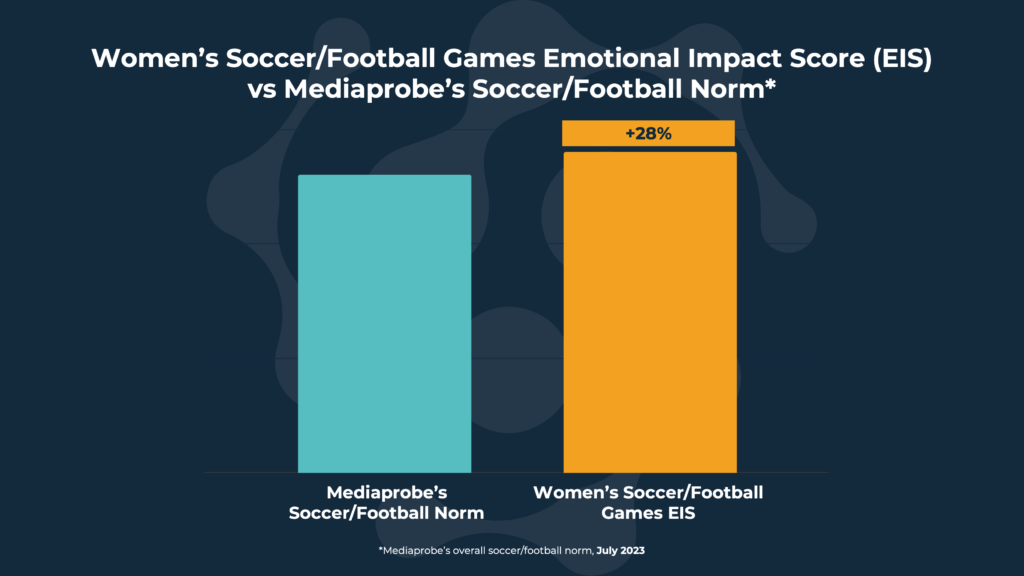
More interestingly, women’s matches outscored the equivalent men’s games by 5%. These results show an evolving landscape where we can see women’s games becoming more emotionally impactful and engaging. And while the audience ratings for women’s games aren’t on par with men’s soccer/football, this rising interest shows that the growth potential is clearly present.
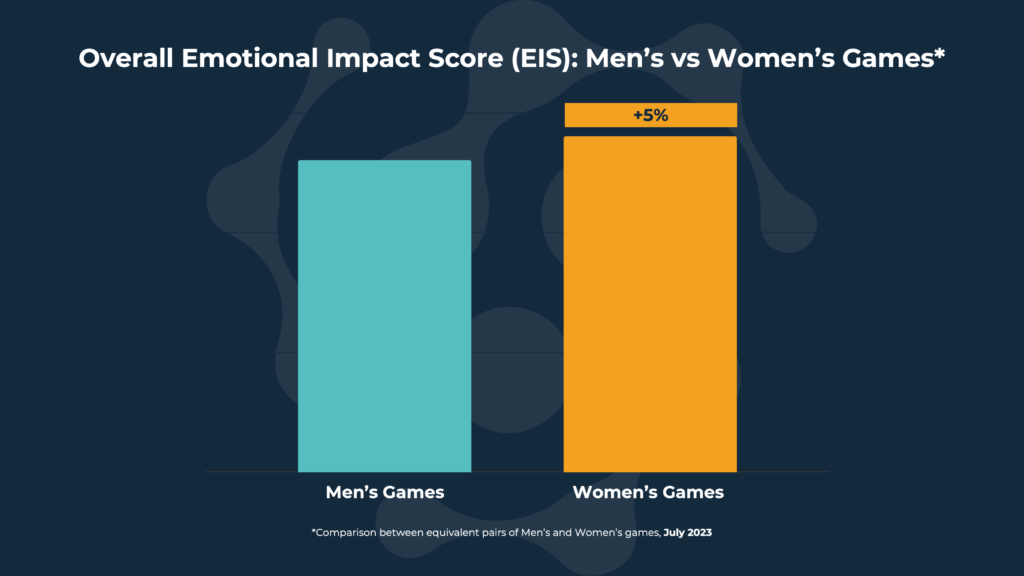
Peak emotionally impactful moments and games’ different emotional profiles
By looking at the overall engagement, women’s games achieved a higher EIS. Yet, men’s games had higher peak emotional moments – the matches led viewers to more moments of stronger emotional impact.
In fact, men’s games were 2.5x more likely to create high peak emotionally impactful moments, something we saw during our Men’s World Cup analysis (update: and most recently the UEFA Champions League). This difference might be due to the fact that men’s games in our sample had a higher number of goals on average (men’s games: 2.8 goals vs women’s games: 1.8 goals).
The data highlights what seems to be a different emotional profile of men’s and women’s soccer games. Whereas men’s games seem to elicit stronger peak emotional impact moments, we see women’s games showing less of those peak moments but having a more stable emotional impact on viewers throughout the match. A perspective that highlights the growing interest of audiences in women’s sports.
Emotional Impact Score (EIS) by audience
Both sets of games also elicited different emotional responses in different audiences, with women viewers showing a higher EIS overall, but with a marked difference in the women’s games where they outscored men viewers by 17%. Therefore, while overall we saw that women’s games reached an average higher EIS compared to men’s games, that result is driven by women viewers.
Men, as an audience, continue to show higher emotional reactions to men’s soccer matches, demonstrating there is still a gap that needs to be closed when promoting women’s games. In fact, while women viewers showed only a slightly higher emotional impact for women’s games (+1%), men clearly showed a higher engagement during men’s games with a 12% higher EIS vs during women’s games.
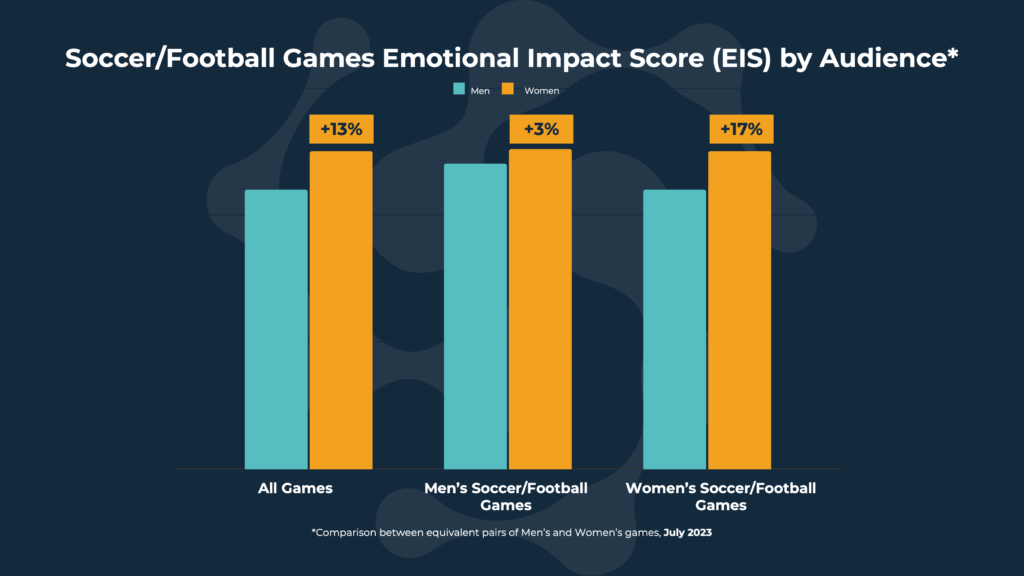
Women’s soccer presents brands with an opportunity to create impact
This shift also presents new possibilities for brands to both amplify and diversify their audiences through women’s soccer partnerships and sponsorships. Indeed, brands seemed eager to grasp the opportunity that the 2023 FIFA Women’s World Cup presented to score with new audiences through direct sponsorships of the tournament and broadcasts, by partnering with athletes, or by buying commercial space during the games.
Our analysis shows that betting on women’s soccer games yields tangible benefits for brands. Both sponsors and regular advertisers achieved higher EIS in women’s games when compared to equivalent men’s counterparts. Moreover, sponsor ads in women’s games scored 6.5% higher than what men’s games scored for sponsors during equivalent games, while the difference for commercials was even higher with women’s games outperforming men’s by 15.3%.
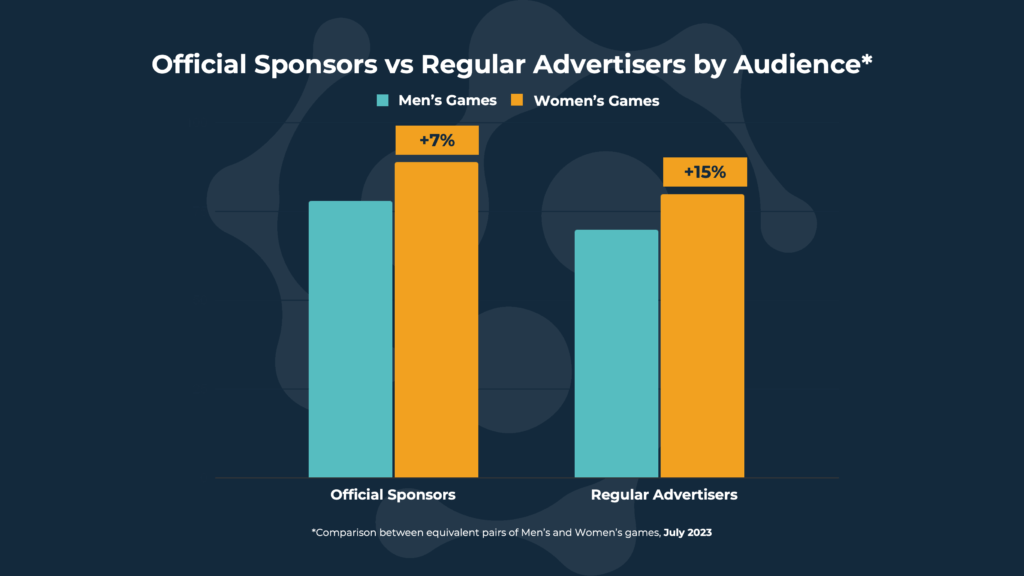
Even more relevant from a brand awareness perspective, brand recall measured in post-game surveys was in line with women’s games with 3% more viewers being able to correctly recall at least one brand at the end of the game. Both sets of games showed to be a good avenue to promote brand awareness, with most brands present during the broadcast being correctly named in post-game free recall questions (brands correctly remembered – women’s games: 86% vs men’s games: 87%).
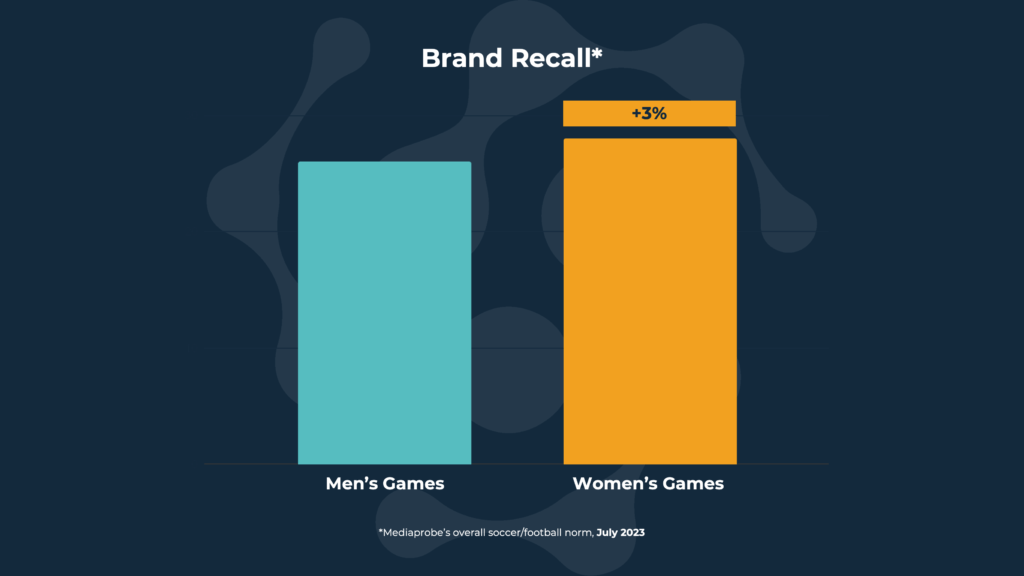
High-quality content impacts ad performance
As mentioned, we are still ways off from seeing women’s soccer achieve the reach of men’s tournaments. HOWEVER, reach is one thing, but the quality of impressions is what advertisers need to prioritize.
We see that ads placed in commercial breaks in high-quality content perform better. High-quality content is the type of content that succeeds in engaging viewers on a deeper emotional level, like we see happening with women’s soccer broadcasts. This is key as emotional engagement correlates with brand outcomes such as brand recall.
What happens here is that advertising benefits from the content’s carry-over effect. If the viewers/listeners are excited by a piece of content, they will produce a higher emotional response to ads placed immediately after it. Furthermore, if brands identify moments that elicit the strongest emotional response, they can strategically place their messages and capitalize on the carry-over effect.
Final thoughts
Looking into our data, and the growing evidence of a cultural change in the perception of women’s sports, particularly women’s soccer, it is clear that there is an untapped potential. Brands and broadcasters stand to gain significantly by seizing this opportunity.
It’s true that there is still a long way to go before we see the differences in audience ratings for men’s and women’s games diminish. Nevertheless, a smart strategy that looks to understand how best to leverage the high emotional impact of women’s soccer games to achieve high-quality impressions will certainly lead to a win for brands that consider viewers’ emotional engagement with content when building their media plan.
*The world’s largest database of emotional reactions to televised content (over 200,000 hours of biometric data).




